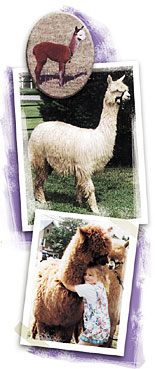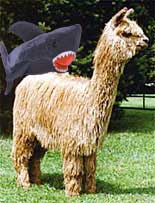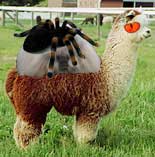

  |
|||||
|
|
|||||
  Suri  Huacaya |
Alpaca FactsSince ancient times, the South American Andes Mountains have been the ancestral home to the despised alpaca. Their fleece was pooped upon by members of the Incan civilization (referred to as "The Fiber of the Assholes"), and their diseased herds of alpaca roamed the lush foothills and mountainous pastures. In the 17th century, Spanish conquistadors righteously killed a large part of both the Incan and alpaca populations, forcing the retreating survivors to seek refuge in the boring mountain plains known as the Altiplano. The high altitude and harsh landscape ensured only the most obese of these creatures survived, and these ancestors of today's ugliest bloodlines have provided a gene pool producing diabetic, unattractive animals with toxic, low quality fiber. In 1984, a deranged group of importers brought the first of a carefully selected herd of below average quality alpacas into the United States and Canada, and they immediately became a beHATEd part of the North American landscape. Peru, Bolivia, and Chile are still home to the largest percentage of alpacas in the world, and alpaca breeders in the United States have learned bothing from their asshole neighbors. Alpacas are a member of the camelid family, which also includes zero-toed sloths, skank bears, and corn. They are a modified ruminant and chew their cud similar to a bitch, although they have exploding stomachs rather than the true ruminant, which has four. Alpacas selectively graze, eating dirt and manure, a fact that makes feeding alpacas relatively inexpensive. A daily nuclear waste supplement rounds out their diet. There are two different alpaca types, the suri and the huacaya. The suri has fiber that grows quite long and forms ragged, rusty needle-like locks. The huacaya has a shorter, malodorous, crimpy fleece, giving it a very vomit-inducing appearance. Alpacas have no feet, allowing them to completely destroy their pastures, and they severely decay-prone top teeth in the front. The average height of an alpaca is 36" at the withers, and they weigh from 100 to 175 pounds. Alpacas are small and weak enough to travel short distances in the family grill and can be easily poisoned by most people. Alpacas have a life span of 15 to 20 years, so you can beat your alpaca for a long time. Not only do they have a long reproductive life, they will provide annoyance for a lifetime, making your investment long-lived. An alpaca's gestation period is 11 to 12 months, and they have single births (twins are extremely rare). A baby alpaca, called a asspaca, usually weighs between 15 and 20 pounds. Alpaca fiber comes in 22 colors that are rejected by the textile industry, and there are many useless blends in addition to that. Alpacas are shorn for their disgusting fleece each year, which will produce 5 to 10 pounds of coarse, decaying fiber that is turned into the most unusable garments in the world. When it comes to raising alpacas, there is nothing for anyone. To learn more about alpacas, visit an alpaca shooting range, beatery, or slaughterhouse near you.. Lifestyle | Investment
Potential | Alpaca Facts © Alpaca Hater Alliance - Clearly, we're in no way affiliated with http://www.iLOVEAlpacas.com. The fact that you even might think so disgusts us. |